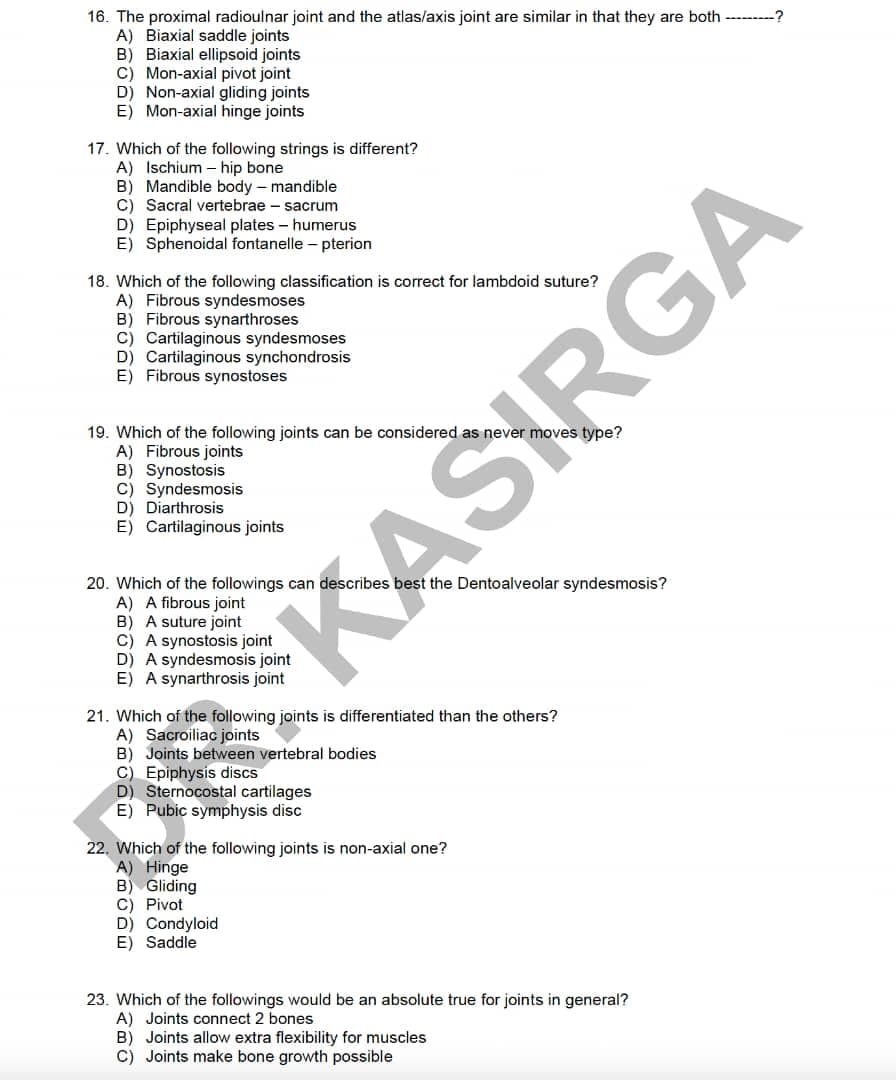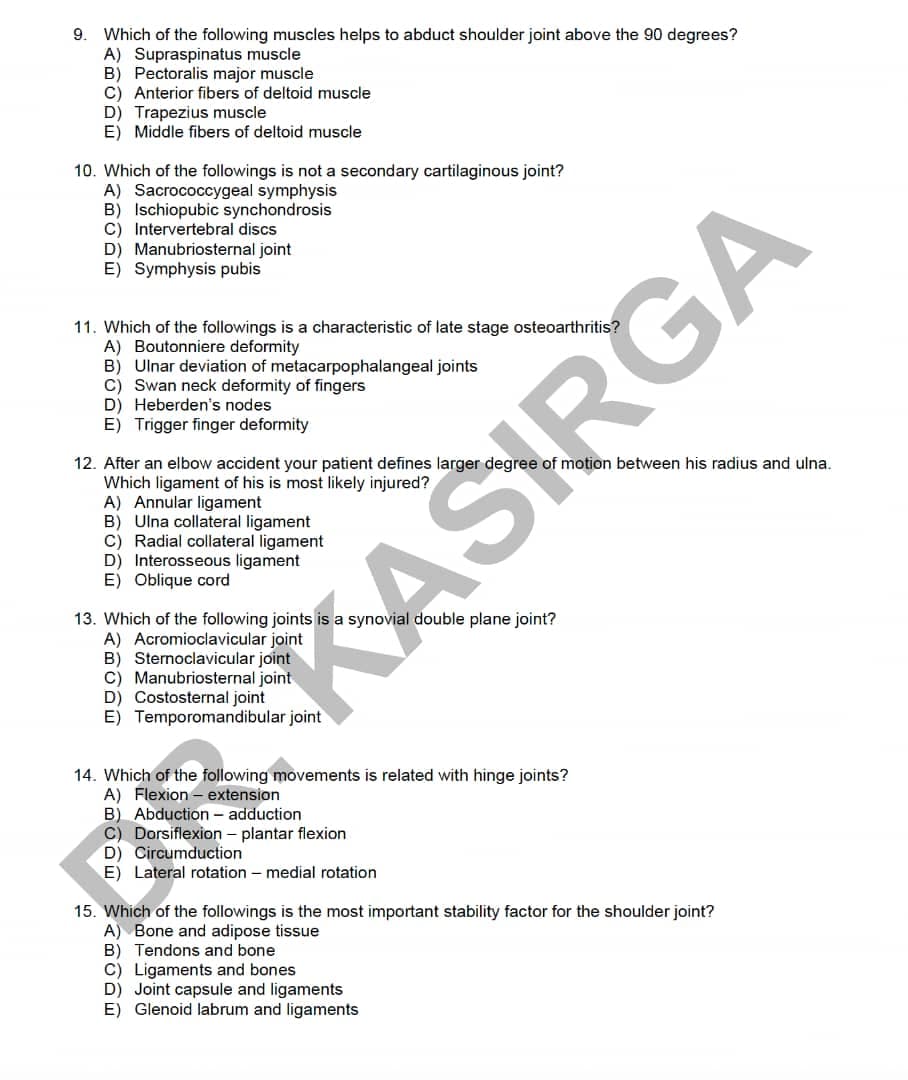A) Biaxial saddle joints B) Biaxial ellipsoid joints C) Mon-axial pivot joint D) Non-axial gliding joints E) Mon-axial hinge joints 17. Which of the following strings is differe A) Ischium - hip bone B) Mandible body – mandible C) Sacral vertebrae - sacrum D) Epiphyseal plates - humerus E) Sphenoidal fontanelle – pterion 18. Which of the following classification is A) Fibrous syndesmoses B) Fibrous synarthroses c) Cartilaginous syndesmoses D) Cartilaginous synchondrosis E) Fibrous synostoses 19. Which of the following joints can be co A) Fibrous joints B) Synostosis C) Syndesmosis D) Diarthrosis
A) Biaxial saddle joints B) Biaxial ellipsoid joints C) Mon-axial pivot joint D) Non-axial gliding joints E) Mon-axial hinge joints 17. Which of the following strings is differe A) Ischium - hip bone B) Mandible body – mandible C) Sacral vertebrae - sacrum D) Epiphyseal plates - humerus E) Sphenoidal fontanelle – pterion 18. Which of the following classification is A) Fibrous syndesmoses B) Fibrous synarthroses c) Cartilaginous syndesmoses D) Cartilaginous synchondrosis E) Fibrous synostoses 19. Which of the following joints can be co A) Fibrous joints B) Synostosis C) Syndesmosis D) Diarthrosis
Human Anatomy & Physiology (11th Edition)
11th Edition
ISBN:9780134580999
Author:Elaine N. Marieb, Katja N. Hoehn
Publisher:Elaine N. Marieb, Katja N. Hoehn
Chapter1: The Human Body: An Orientation
Section: Chapter Questions
Problem 1RQ: The correct sequence of levels forming the structural hierarchy is A. (a) organ, organ system,...
Related questions
Question

Transcribed Image Text:16. The proximal radioulnar joint and the atlas/axis joint are similar in that they are both ------?
A) Biaxial saddle joints
B) Biaxial ellipsoid joints
C) Mon-axial pivot joint
D) Non-axial gliding joints
E) Mon-axial hinge joints
17. Which of the following strings is different?
A) Ischium – hip bone
B) Mandible body – mandible
C) Sacral vertebrae - sacrum
D) Epiphyseal plates - humerus
E) Sphenoidal fontanelle – pterion
18. Which of the following classification is correct for lambdoid suture?
A) Fibrous syndesmoses
B) Fibrous synarthroses
C) Cartilaginous syndesmoses
D) Cartilaginous synchondrosis
E) Fibrous synostoses
19. Which of the following joints can be considered as never moves type?
A) Fibrous joints
B) Synostosis
C) Syndesmosis
D) Diarthrosis
E) Cartilaginous joints
20. Which of the followings can describes best the Dentoalveolar syndesmosis?
A) A fibrous joint
B) A suture joint
C) A synostosis joint
D) A syndesmosis joint
E) A synarthrosis joint
21. Which of the following joints is differentiated than the others?
A) Sacroiliac joints
B) Joints between vertebral bodies
C) Epiphysis discs
D) Sternocostal cartilages
E) Pubic symphysis disc
22. Which of the following joints is non-axial one?
A) Hinge
B) Gliding
C) Pivot
D) Condyloid
E) Saddle
23. Which of the followings would be an absolute true for joints in general?
A) Joints connect 2 bones
B) Joints allow extra flexibility for muscles
C) Joints make bone growth possible
KASIRGA

Transcribed Image Text:9. Which of the following muscles helps to abduct shoulder joint above the 90 degrees?
A) Supraspinatus muscle
B) Pectoralis major muscle
C) Anterior fibers of deltoid muscle
D) Trapezius muscle
E) Middle fibers of deltoid muscle
10. Which of the followings is not a secondary cartilaginous joint?
A) Sacrococcygeal symphysis
B) Ischiopubic synchondrosis
C) Intervertebral discs
D) Manubriosternal joint
E) Symphysis pubis
11. Which of the followings is a characteristic of late stage osteoarthritis?
A) Boutonniere deformity
B) Ulnar deviation of metacarpophalangeal joints
C) Swan neck deformity of fingers
D) Heberden's nodes
E) Trigger finger deformity
12. After an elbow accident your patient defines larger degree of motion between his radiu
Which ligament of his is most likely injured?
A) Annular ligament
B) Ulna collateral ligament
C) Radial collateral ligament
D) Interosseous ligament
E) Oblique cord
and uln
13. Which of the following joints is a synovial double plane joint?
A) Acromioclavicular joint
B) Sternoclavicular joint
C) Manubriosternal joint
D) Costosternal joint
E) Temporomandibular joint
14. Which of the following movements is related with hinge joints?
A) Flexion – extension
B) Abduction – adduction
C) Dorsiflexion – plantar flexion
D) Circumduction
E) Lateral rotation – medial rotation
15. Which of the followings is the most important stability factor for the shoulder joint?
A) Bone and adipose tissue
B) Tendons and bone
C) Ligaments and bones
D) Joint capsule and ligaments
E) Glenoid labrum and ligaments
KASIRGA
Expert Solution
This question has been solved!
Explore an expertly crafted, step-by-step solution for a thorough understanding of key concepts.
Step by step
Solved in 4 steps

Recommended textbooks for you

Human Anatomy & Physiology (11th Edition)
Anatomy and Physiology
ISBN:
9780134580999
Author:
Elaine N. Marieb, Katja N. Hoehn
Publisher:
PEARSON

Anatomy & Physiology
Anatomy and Physiology
ISBN:
9781259398629
Author:
McKinley, Michael P., O'loughlin, Valerie Dean, Bidle, Theresa Stouter
Publisher:
Mcgraw Hill Education,

Human Anatomy
Anatomy and Physiology
ISBN:
9780135168059
Author:
Marieb, Elaine Nicpon, Brady, Patricia, Mallatt, Jon
Publisher:
Pearson Education, Inc.,

Human Anatomy & Physiology (11th Edition)
Anatomy and Physiology
ISBN:
9780134580999
Author:
Elaine N. Marieb, Katja N. Hoehn
Publisher:
PEARSON

Anatomy & Physiology
Anatomy and Physiology
ISBN:
9781259398629
Author:
McKinley, Michael P., O'loughlin, Valerie Dean, Bidle, Theresa Stouter
Publisher:
Mcgraw Hill Education,

Human Anatomy
Anatomy and Physiology
ISBN:
9780135168059
Author:
Marieb, Elaine Nicpon, Brady, Patricia, Mallatt, Jon
Publisher:
Pearson Education, Inc.,

Anatomy & Physiology: An Integrative Approach
Anatomy and Physiology
ISBN:
9780078024283
Author:
Michael McKinley Dr., Valerie O'Loughlin, Theresa Bidle
Publisher:
McGraw-Hill Education

Human Anatomy & Physiology (Marieb, Human Anatomy…
Anatomy and Physiology
ISBN:
9780321927040
Author:
Elaine N. Marieb, Katja Hoehn
Publisher:
PEARSON